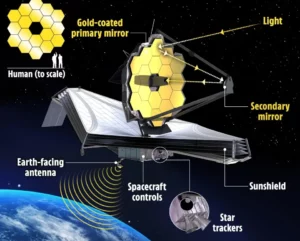The James Webb Space Telescope (JWST), named after the former NASA administrator who crafted the Apollo lunar exploration program, represents a giant leap forward in our quest to understand the cosmos. Its development journey began in 1996 as a collaborative project involving NASA, the European Space Agency (ESA), and the Canadian Space Agency (CSA). JWST is often hailed as the successor to the Hubble Space Telescope, not just due to its advanced capabilities but also for its role in continuing a legacy of cosmic discovery. With a mission to explore every phase of cosmic history, JWST’s deployment is poised to usher in a new era of astronomy.
Design and Features of JWST
From its inception, JWST was engineered to surpass its venerable predecessor. The telescope boasts a primary mirror 6.5 meters in diameter, composed of 18 hexagonal segments made from gold-coated beryllium that can unfold once launched into space. This large aperture allows JWST to collect more light from faint astronomical objects.
One of JWST’s most striking design elements is its five-layer sunshield, each layer as thin as a human hair. This tennis court-sized protector shields the telescope from the Sun’s heat and light, maintaining its instruments at cryogenic temperatures essential for infrared observations.
The onboard suite of scientific instruments includes cameras and spectrometers capable of capturing images and spectra across a wide range of infrared wavelengths. These technologies enable JWST to peer back over 13.5 billion years to observe the first galaxies that formed after the Big Bang and detect high redshift objects whose light has been stretched into infrared wavelengths due to the expansion of the universe.

James Webb Space Telescope (JWST), photo from presentation.
Mission Goals and Scientific Objectives
JWST has four central scientific objectives: to study galaxy formation and evolution; to understand star and planet formation; to observe planetary systems and the origins of life; and finally, to explore our own solar system. By penetrating dusty regions where stars and planetary systems are born, JWST will offer new insights into these fundamental processes.
The telescope’s sensitive instruments are also capable of analyzing the atmospheres of exoplanets, potentially identifying markers that suggest habitability or even life. Furthermore, through detailed observations of distant galaxies, JWST is expected to shed light on dark matter’s role in galaxy assembly and on dark energy’s mysterious influence on cosmic acceleration.
Impact on Astronomy and Beyond
The scientific yield from JWST will likely be transformative across various disciplines — from astrophysics where it will deepen our understanding of black holes, neutron stars, and other extreme objects, to cosmology where it will help elucidate cosmic background radiation nuances.
Astrobiology also stands on the cusp of potential breakthroughs with data from JWST guiding research into prebiotic chemistry beyond Earth. The public sharing of breathtaking images captured by this observatory is set not only to captivate imaginations but also spark an amplified interest in space exploration amongst people worldwide.
In conclusion, as much as it is an engineering marvel, JWST is a beacon for humanity’s insatiable curiosity about existence itself. Its analyses may eventually touch upon philosophical realms by contributing foundational knowledge about where we come from and whether we are alone in this vast universe—an endeavor that transcends science alone.


